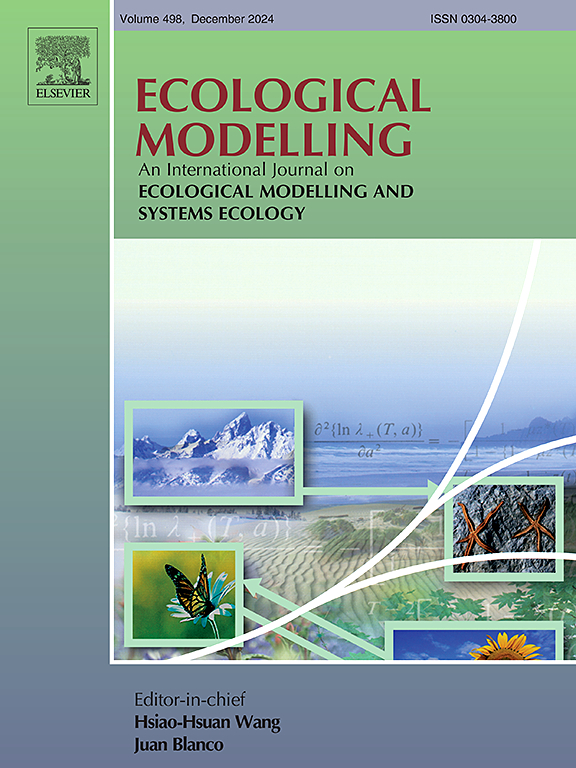生长在边缘:模拟山桦树(Betula pubescens ssp)树苗定植、性能和有效范围。tortuosa)
IF 2.6
3区 环境科学与生态学
Q2 ECOLOGY
引用次数: 0
摘要
将现有林地的树木迁移到邻近的开放林地是被动恢复的关键过程,导致次生林地的形成。这一过程的重要驱动因素包括对周围林地的遮蔽,这既会影响定植的空间范围,也会影响单个树苗的表现。本文分析了遮荫和林冠高度对山地桦树自然定植模式和单株树苗性能的影响。在冰岛的不同地区。我们沿着样带测量了树苗密度和单个树苗形态,并使用双曲核函数模拟了定植。随后,我们利用这些定植核来定义和计算山地桦树定植的有效空间范围。结果表明,区域环境对山地桦树幼树的生长发育有明显的影响。不同地区桦木定植的有效空间范围差异较大,从低矮桦木的16.6 m到高直桦木的67.4 m不等。此外,我们还发现单个树苗的表现是遮荫的直接产物,因为本研究中使用的树形态指数与一个核函数参数显著相关。我们的研究结果强调了周围林地对殖民化模式和个体树苗表现的重要性,尽管冰岛的遮蔽效果通常较低。在研究和实践中应考虑到这一点,将自然定植与有效的本地化种植相结合。有效的空间范围有助于在这两种恢复方法之间找到适当的平衡。本文章由计算机程序翻译,如有差异,请以英文原文为准。
Growing at the edge: Modelling sapling colonization, performance, and effective range of mountain birch (Betula pubescens ssp. tortuosa)
Colonization of trees from existing woodlands into adjacent open lands is a critical process of passive restoration, leading to the formation of secondary woodlands. Important drivers of this process include sheltering from surrounding woodlands, which can affect both the spatial range of colonization and the performance of individual saplings. In this study we analysed the effects of sheltering and canopy height on the patterns of natural colonization and individual sapling performance of mountain birch (Betula pubescens ssp. tortuosa) in different regions of Iceland. We measured sapling densities and individual sapling morphology along transects, and modelled colonization using hyperbolic kernel functions. We subsequently used these colonization kernels to define and calculate the effective spatial range for mountain birch colonization. The results showed a clear effect of regional environments on the performance of mountain birch saplings. The effective spatial range of colonization varied greatly between regions, ranging from 16.6 m in areas with birch of low stature, to 67.4 m in the region with the tallest, straightest stems. We furthermore saw that individual sapling performance was a direct product of sheltering, as one kernel function parameter was significantly correlated with the tree morphology index used in this study. Our results highlighted the importance of sheltering from surrounding woodlands on both colonization patterns and on individual sapling performance, though sheltering effects are generally low in Iceland. This should be considered in research as well as practice by combining natural colonization with efficient localized planting. The effective spatial range can aid in finding an appropriate balance between these two restoration methods.
求助全文
通过发布文献求助,成功后即可免费获取论文全文。
去求助
来源期刊

Ecological Modelling
环境科学-生态学
CiteScore
5.60
自引率
6.50%
发文量
259
审稿时长
69 days
期刊介绍:
The journal is concerned with the use of mathematical models and systems analysis for the description of ecological processes and for the sustainable management of resources. Human activity and well-being are dependent on and integrated with the functioning of ecosystems and the services they provide. We aim to understand these basic ecosystem functions using mathematical and conceptual modelling, systems analysis, thermodynamics, computer simulations, and ecological theory. This leads to a preference for process-based models embedded in theory with explicit causative agents as opposed to strictly statistical or correlative descriptions. These modelling methods can be applied to a wide spectrum of issues ranging from basic ecology to human ecology to socio-ecological systems. The journal welcomes research articles, short communications, review articles, letters to the editor, book reviews, and other communications. The journal also supports the activities of the [International Society of Ecological Modelling (ISEM)](http://www.isemna.org/).
 求助内容:
求助内容: 应助结果提醒方式:
应助结果提醒方式:


